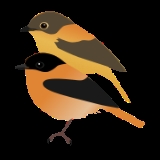
Black-and-orange Flycatcher
Encyclopedia
The Black-and-orange Flycatcher (Ficedula nigrorufa) is a species of flycatcher
endemic to the central and southern Western Ghats
, the Nilgiris
and Palni
hill ranges in southern India. It is unique among the Ficedula flycatchers in having rufous coloration on its back and prior to molecular studies was suggested to be related to the chats and thrushes.
 A distinctly coloured bird found mainly in the high-elevation areas of the Western Ghats
A distinctly coloured bird found mainly in the high-elevation areas of the Western Ghats
, the Nilgiris, the Palnis and associated hill ranges. The male is distinctly black headed with black wings. The female has the black replaced by dark brown and has a light eye-ring. They are usually seen singly or in pairs.
The peak feeding activity of the birds is early in the morning and close to dusk. During these times they got as many as 100 insects per hour whereas during mid-day they were half as efficient.
Old World flycatcher
The Old World flycatcher family Muscicapidae is a large family of small passerine birds mostly restricted to the Old World. These are mainly small arboreal insectivores, many of which, as the name implies, take their prey on the wing.-Characteristics:...
endemic to the central and southern Western Ghats
Western Ghats
The Western Ghats, Western Ghauts or the Sahyādri is a mountain range along the western side of India. It runs north to south along the western edge of the Deccan Plateau, and separates the plateau from a narrow coastal plain along the Arabian Sea. The Western Ghats block rainfall to the Deccan...
, the Nilgiris
Nilgiris (mountains)
The Nilgiri , often referred to as the Nilgiri Hills, are a range of mountains with at least 24 peaks above , in the westernmost part of Tamil Nadu state at the junction of Karnataka and Kerala states in Southern India...
and Palni
Palni Hills
The Palni Hills are a mountain range in Tamil Nadu state of South India. The Palni Hills are an eastward extension of the Western Ghats ranges, which run parallel to the west coast of India. The Palni Hills adjoin the high Anamalai range on the west, and extend east into the plains of Tamil Nadu,...
hill ranges in southern India. It is unique among the Ficedula flycatchers in having rufous coloration on its back and prior to molecular studies was suggested to be related to the chats and thrushes.
Description

Western Ghats
The Western Ghats, Western Ghauts or the Sahyādri is a mountain range along the western side of India. It runs north to south along the western edge of the Deccan Plateau, and separates the plateau from a narrow coastal plain along the Arabian Sea. The Western Ghats block rainfall to the Deccan...
, the Nilgiris, the Palnis and associated hill ranges. The male is distinctly black headed with black wings. The female has the black replaced by dark brown and has a light eye-ring. They are usually seen singly or in pairs.
Distribution and habitat
The main population of this bird is found in the high elevation plateaus (above 1500m) areas of the Nilgiris, Palani Hills, Biligirirangans (Bellaji and Honnametti) and Kannan Devan Hills. They prefer areas with high leaf litter and undergrowth in open shola grassland habitats. The density was about 2.8 ha per pair during the breeding season. It is a highly parochial bird and no local movements other than dispersal of young has been noted. To the north, it occurs in the Kudremukh National Park and the Bababudan Hills and south to the Ashambu Hills. Some old records of the species from Maharashtra and Sri Lanka have been considered dubious.Behaviour and ecology
In the breeding season, March to May, these birds are very vocal and they have a repetitive "chee-ri-rirr" or a whistling song "whee-chee-ree-rirr". The feed on insects by flycatching low over the ground (under 2m height) and also pick insects from the ground. Territories are maintained by a pair throughout the year. The threat display involves the male pointing bill up, fanning the tail, opening wings and producing "keet-keet" notes. The alarm call is a zit-zit. Males are usually involved in defense but females may sometimes join in. The nest is built by the female, placed in a low bush or fern. Two greyish speckled eggs form the usual clutch. Young birds are brownish and speckled. The nest is unlike that of most flycatchers and is large, coarse, ball-like and made from sedges. The nest has a foundation of dry leaves and ferns. The nest has an external diameter of at least 6 inches and the egg cavity is devoid of lining and about 2 inches in diameter and 2 inches deep. The nest is placed usually at the centre of a bush at about 1 to 3 feet height with an entrance hole close to the top.The peak feeding activity of the birds is early in the morning and close to dusk. During these times they got as many as 100 insects per hour whereas during mid-day they were half as efficient.
Other sources
- Khan,MAR (1979) Field characters and juvenile plumage of Muscicapa nigrorufa (Jerdon). Bangladesh J. Zool. 7(2):109-112.
- Khan,MAR (1977) Ecology and Behaviour of the Black-and-Orange Flycatcher Muscicapa nigrorufa. Ph.D. Thesis, Bombay University, Bombay.

